If you're interested in the OKR goal-setting framework and need a starting point, an OKR template is a great foundation. Our guide will cover:
- The importance of OKRs
- Key elements of an OKR template
- Steps to create your first OKR template
- Popular and advanced OKR template examples
Let's dive into these topics in more detail.
Why Do You Need OKRs?
The Objectives and Key Results (OKR) goal-setting framework has gained popularity due to its ability to align organizational strategy with execution. Their transparency makes strategic plans easily shareable, fostering a common purpose within the organization and enhancing overall alignment.
A major challenge in executing strategy is the lack of clear articulation of the strategy and alignment of efforts. Indeed, effective strategic alignment is crucial in project and portfolio management, requiring continuous assessment and adjustment of project portfolios to stay in sync with evolving business goals.
According to the latest Agile community report, 32% of Agile practitioners use OKRs linked to epics for executive-level delivery measurement. Creating a strategic roadmap will help you understand the relationship between goals, measurements, and value creation.
 Visualization of OKRs on a strategic and portfolio organization level in Businessmap
Visualization of OKRs on a strategic and portfolio organization level in Businessmap
Aligning company plans with employee goals also boosts engagement and motivation. When strategic and team goals are transparent, team members can see how their efforts contribute to the organization's strategy, enhancing their sense of belonging and morale.
Given the challenges of implementing OKRs, starting with an OKR template can provide you with a solid foundation, making the process more manageable and effective.
What Is an OKR Template?
An OKR template is a versatile tool that can be a document, spreadsheet, or digital dashboard designed to visualize the goals and key results of a team, department, or entire organization. By using a digital OKR dashboard or template, companies can ensure alignment between strategic goals and actual work delivery across all levels.
Consider an OKR template as the foundation for adopting the OKR goal-setting framework. It allows you to establish your initial OKR setup and continuously refine it to suit your unique needs and scenarios. This iterative process helps you adapt and improve your approach to goal-setting, ensuring better alignment and objective achievement.
OKR Template: Format and Key Characteristics
No matter which OKR template you start with, it's essential that your chosen OKR solution clearly visualizes the following elements:
1. Defined Owner: The person, team, department, or organization owning the specified objectives and key results.
2. Defined Time Box: Visible indication of the agreed-upon time frames for which the specified OKRs were written.
3. Objectives: The specific, measurable, and achievable goals the team or company has set. Depending on your context, the number of objectives will vary.
4. Key Results: Key Results will help you evaluate and track the execution of each objective. They indicate activities that come in short sentences and must be specific, realistic, and measurable.
5. Progress Indication: A progress bar or percentile to track the completion of each objective.
OKR Template Sample for Operations Teams
Here's an example that depicts an OKR (Objectives and Key Results) template for the IT Operations Department. It outlines the department's goals for Q3, including the main objective to "Improve Service Infrastructure" and key results such as migrating services to a cloud infrastructure, reducing service downtime by 30%, and reducing response time by 20%. The progress of each key result is tracked, with percentages shown for each.
 IT Operations department OKRs template made using MS Excel
IT Operations department OKRs template made using MS Excel
5 OKR Templates for Beginners and Advanced Users
Here are five sample OKR templates that can be tailored for various contexts, functions, departments, or organizational roles. Each template includes essential data and offers a general overview of the goal, key results, the owner, and the set time frame.
1. OKR Document Template
Referring to the IT Operations OKR example listed above, you can copy the template and modify it to your specific work environment. You can create the same OKR template in Google Sheets or a basic Microsoft Word document.
 OKR template example made using MS Word and Google Docs
OKR template example made using MS Word and Google Docs
2. OKR Planning Template
For planning your OKRs, you can also have a basic Excel or Google spreadsheet template where you list your primary goals, their owners, and when you plan to achieve them.
Planning your objectives based on specific segments, such as the "AARRR" framework (Acquisition, Activation, Retention, Referrals, Revenue), can lead to better organization in your planning efforts. This approach allows teams to collaborate on setting important goals for the next quarter, ensuring alignment with the organization's strategic objectives. The specific segments you choose should depend on your unique situation and function within the organization.

Example of a basic OKR planning template in Google Sheets
After you’ve listed your planned OKRs, you can move on to creating a document to track and evaluate your goals.
How Two of The Largest Organizations in the World Save Time & Money with OKRs?
3. OKR Tracking Template
To closely monitor the progress of each objective, you can adjust your OKR template using one of the OKR scoring methods. This approach is suitable for tracking the level of execution of each key result in a given time frame (e.g., quarter). You can grade the performance on a weekly basis and get a final score for completing your objectives.
Traditional OKR grading employs a scale from 0.0 to 1.0 and color-coding to rate the level of success reached for each key result. To arrive at your objective's final score, sum up the weekly scores of your key results and divide them by the number of weeks.
Looking at the example below, to get the final score of objective 1, the formula would look like this:
Objective 1 Final Score = (Key Result Score for Week 1 + Key Result Score for Week 2 + Key Result Score for Week 3 + Key Result Score for Week 4) /4
 OKR template for tracking and scoring completion
OKR template for tracking and scoring completion
4. OKR Initiative Template
You can also visualize initiatives using OKR templates. Initiatives include projects or other big work activities you plan to pursue to achieve your OKRs. In other words, you can think of such work initiatives as "output" from your OKR template.
It’s important to mention that this works best if you have collaboratively created the initial plans for some work activities that support your goals. However, remember that to stay agile, you should regularly revisit your initiatives and OKRs to determine if the chosen activities produce the desired outcomes.
Once you have your OKRs, your team can further plan how to develop the work initiatives as more information becomes available.
 Linking team OKRs with operational deliverables using OKR board in Businessmap
Linking team OKRs with operational deliverables using OKR board in Businessmap
5. OKR Strategy Template
Businessmap's OKR software capabilities enable us to visualize the hierarchy between our strategic plans, team goals, and individual contributions. Based on our experience, here is the essential advice we can offer on how to use OKRs effectively.
- Set top-level goals.
- Enable teams to create their contributing OKRs.
- Link team-level OKRs to company-level OKRs for a transparent overview.
- Ensure all progress is available in a single, accessible view for all contributors.
 Connecting company objectives with team-level goals in Businessmap
Connecting company objectives with team-level goals in Businessmap
What Are the Advantages of Using an OKR Template?
The use of good OKR templates can help teams go far. Besides assisting them in setting strategic goals aligned with the company’s vision and providing a clear direction on how to reach them, the OKRs template’s list offers:
-
Greater collaboration through company-wide transparency. OKR promotes open and effective communication across an organization. This allows teams to understand the organization’s strategic goals and coordinate their activities to achieve them while providing insights into the progress of each team’s objectives and key results.
-
Elevated productivity. Having OKR templates in place helps teams focus on delivering the Key Results that support the set objectives. Defined as measurable outcomes and not output, Key Results focus on the desired results teams seek and the actual value their work will bring to the customer.
-
Engaged and motivated teams. OKR templates boost employees' motivation by letting them contribute to setting OKRs and be aware of the organization's top priorities. This results in creating a sense of belonging and striving for excellent performance.
-
Faster decision-making. OKR's transparent nature allows teams to spot any risks that threaten the work process. Thus, they can address any issue by making quick decisions without disrupting the process and generating additional project costs and delays.
-
Agile OKRs. Embracing the Agile way of working will help organizations stay responsive to the changing market conditions and changing customers' needs. Agile OKRs have shorter cycle times, allowing regular check-ins, fast adaptation to changes, and reduced risks and waste.
Businessmap is the most flexible software
to align work with company goals
In Summary
An OKR template can help you to streamline and put into practice the objectives and key results goal-setting framework. The essential elements of OKR templates structure include:
- Owner
- Time-frame
- Objective(s)
- Key results
- Status (progress)





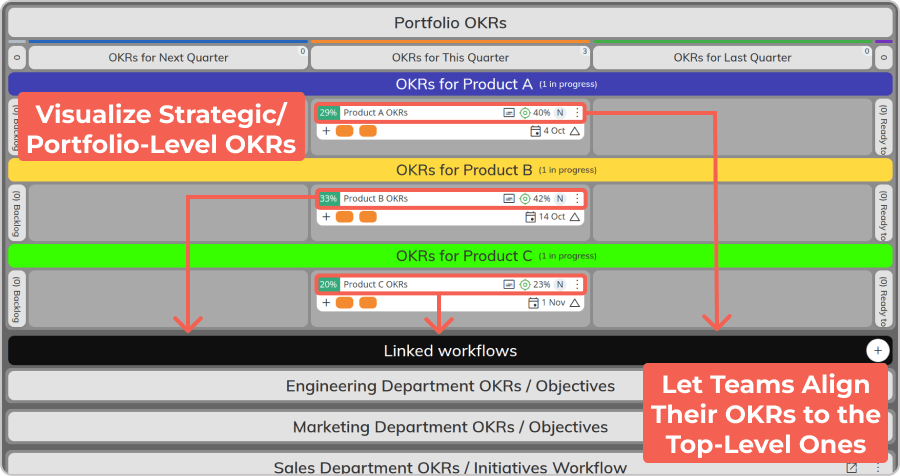 Visualization of OKRs on a strategic and portfolio organization level in Businessmap
Visualization of OKRs on a strategic and portfolio organization level in Businessmap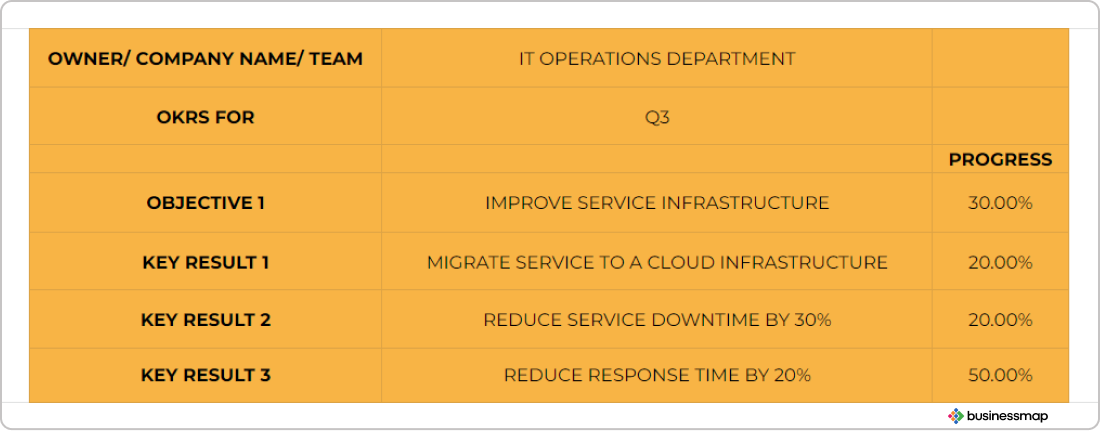 IT Operations department OKRs template made using MS Excel
IT Operations department OKRs template made using MS Excel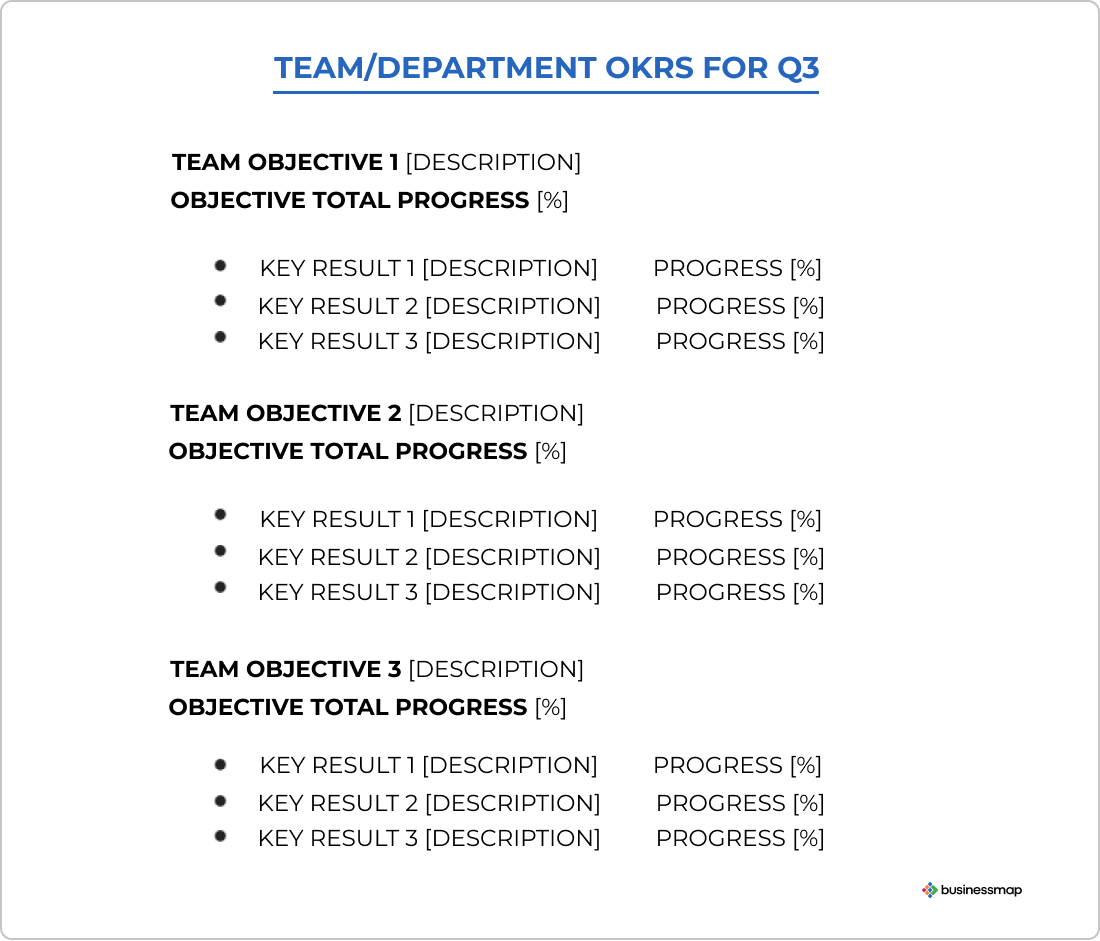 OKR template example made using MS Word and Google Docs
OKR template example made using MS Word and Google Docs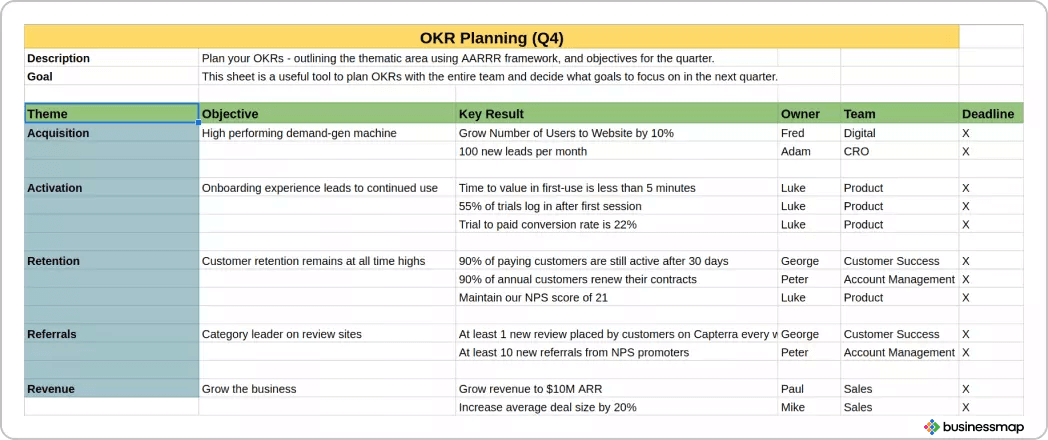
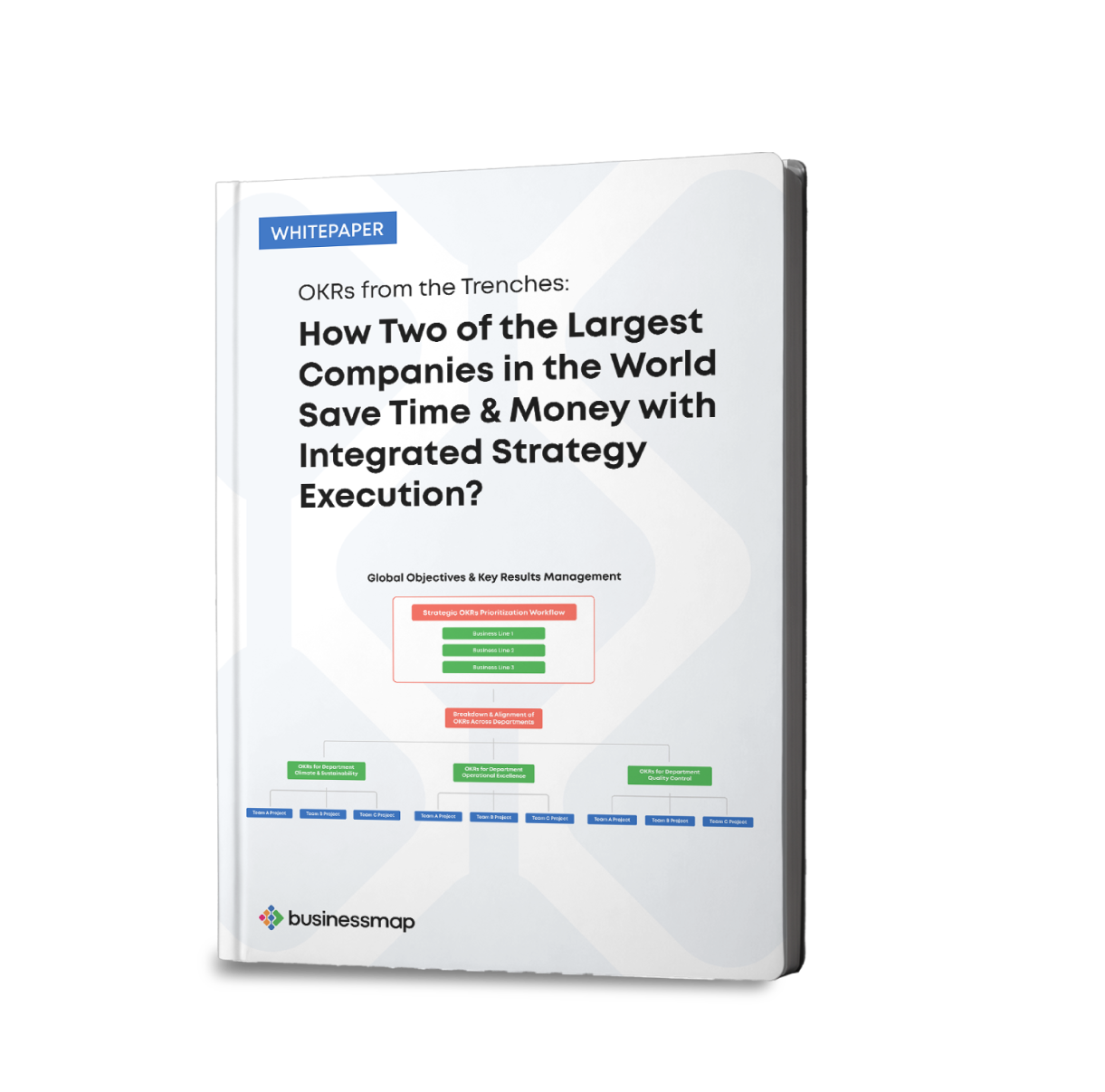
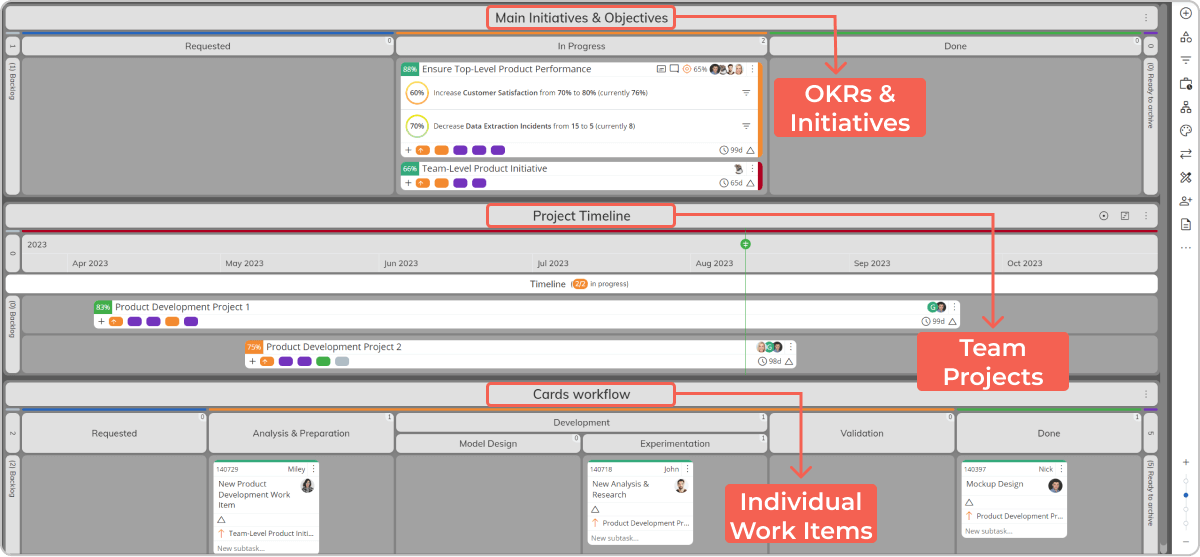 Linking team OKRs with operational deliverables using OKR board in Businessmap
Linking team OKRs with operational deliverables using OKR board in Businessmap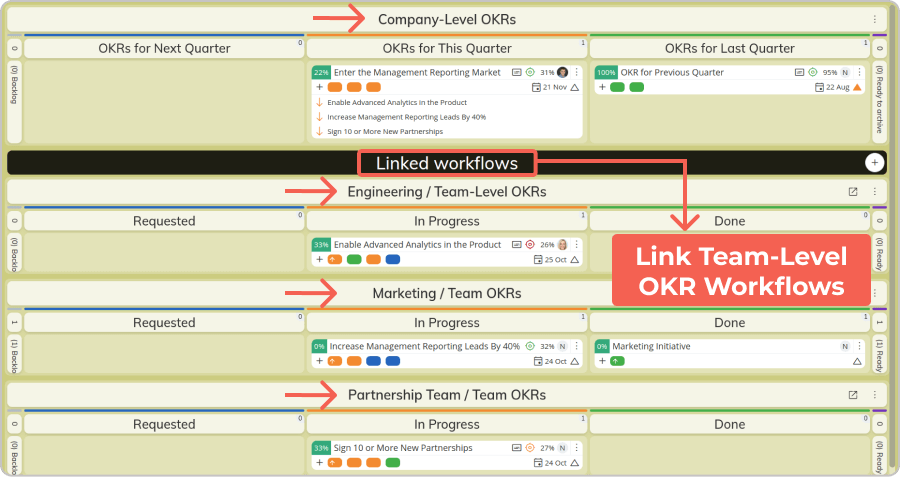 Connecting company objectives with team-level goals in Businessmap
Connecting company objectives with team-level goals in Businessmap

